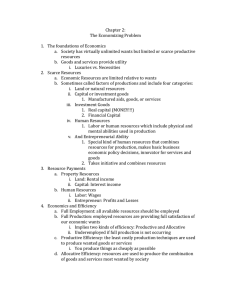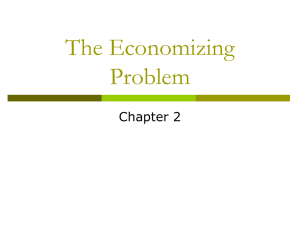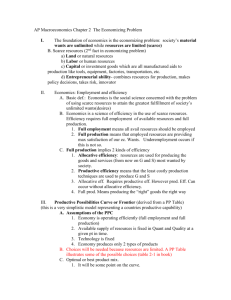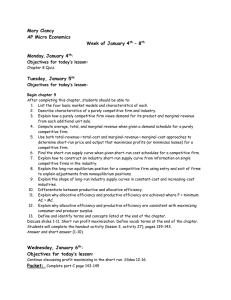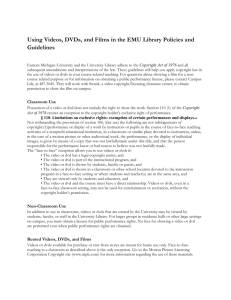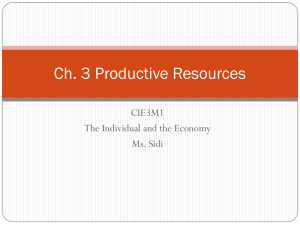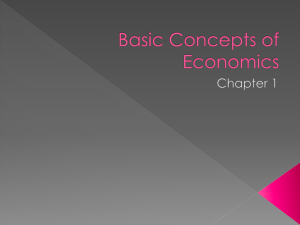Document
advertisement
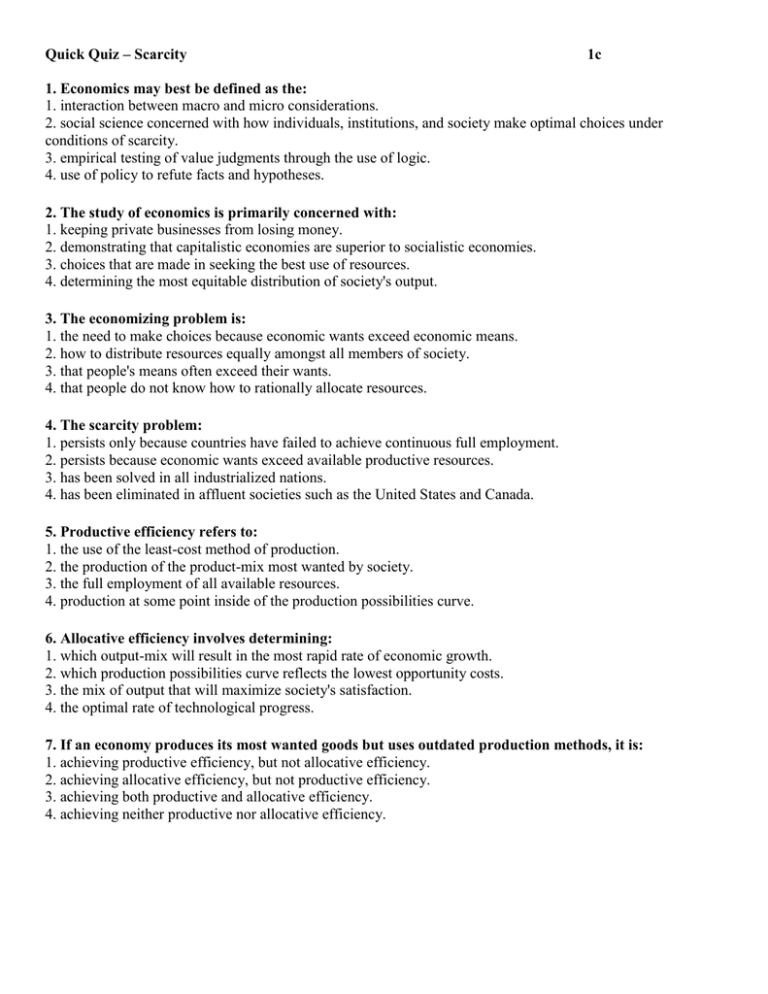
Quick Quiz – Scarcity 1c 1. Economics may best be defined as the: 1. interaction between macro and micro considerations. 2. social science concerned with how individuals, institutions, and society make optimal choices under conditions of scarcity. 3. empirical testing of value judgments through the use of logic. 4. use of policy to refute facts and hypotheses. 2. The study of economics is primarily concerned with: 1. keeping private businesses from losing money. 2. demonstrating that capitalistic economies are superior to socialistic economies. 3. choices that are made in seeking the best use of resources. 4. determining the most equitable distribution of society's output. 3. The economizing problem is: 1. the need to make choices because economic wants exceed economic means. 2. how to distribute resources equally amongst all members of society. 3. that people's means often exceed their wants. 4. that people do not know how to rationally allocate resources. 4. The scarcity problem: 1. persists only because countries have failed to achieve continuous full employment. 2. persists because economic wants exceed available productive resources. 3. has been solved in all industrialized nations. 4. has been eliminated in affluent societies such as the United States and Canada. 5. Productive efficiency refers to: 1. the use of the least-cost method of production. 2. the production of the product-mix most wanted by society. 3. the full employment of all available resources. 4. production at some point inside of the production possibilities curve. 6. Allocative efficiency involves determining: 1. which output-mix will result in the most rapid rate of economic growth. 2. which production possibilities curve reflects the lowest opportunity costs. 3. the mix of output that will maximize society's satisfaction. 4. the optimal rate of technological progress. 7. If an economy produces its most wanted goods but uses outdated production methods, it is: 1. achieving productive efficiency, but not allocative efficiency. 2. achieving allocative efficiency, but not productive efficiency. 3. achieving both productive and allocative efficiency. 4. achieving neither productive nor allocative efficiency. Resource Quiz 1c Each of the following is either a/n: a. consumer good b. consumer service c. land d. capital e. labor f. entrepreneur Your answer: Your answer: medical checkup taxi ride factory automobile highway autoworker candy bar John DeLorean coal ice cream cone coke haircut iron ore waiter Steve Jobs/Steve Wasnik Ted Turner forest crude oil lumber gasoline class lecture stockings 1c The Budget Line: A MODEL of an individual's economizing problem: Definition: A budget line is a schedule (table) or curve (graph) that shows the various combinations of two products that a consumer can purchase with a specific money income Assumptions o there are only two goods to purchase (DVDs and books) o the amount of income to spend is fixed ( $120 gift card ) o The goods have prices (DVD's are $20 and books are $10) Calculate the budget line table and draw the budget line graph What are the combinations of DVDs and books that you can afford? ______#DVDs______ ______# Books______ 0 and 1 and 2 and 3 and 4 and 5 and 6 and What happens if income or prices change? (be able to make a new table and budget line graph) What would happen if income decreases to a $60 gift card (DVD's are $20 and books are $10) ______#DVDs______ ______# Books______ and and and and and and and What would happen if price of DVDs increase to $30 (income stays at $120 and books are $10) ______#DVDs______ ______# Books______ and and and and and and and What would happen if: a. income increases to a $240 gift card ? b. price of DVD decreases to $10 (income stays at $120 and books are $10) ? c. price of books decreases to $5 (income stays at = $120 and DVD's are $20) ? d. price of books increases to $20 (income stays at = $120 and DVD's are $20) ? Quick Quiz – Budget Lines 1c 1. The budget line shows: 1. the amount of product A that a consumer is willing to give up to obtain one more unit of product B 2. all possible combinations of two goods that can be purchased, given money income and the prices of the goods. 3. the minimum amount of two goods that a consumer can purchase with a given money income. 4. all possible combinations of two goods that yield the same level of utility to the consumer. 2. Use the graph above to answer this question. Suppose you have a money income of $10, all of which you spend on Coke and popcorn. In the above diagram, the prices of Coke and popcorn respectively are: 1. $.50 and $1.00. 2. $1.00 and $.50. 3. $1.00 and $2.00. 4. $.40 and $.50. 3. The shift of the budget line from cd to ab in the above figure is consistent with: 1. decreases in the prices of both M and N. 2. an increase in the price of M and a decrease in the price of N. 3. a decrease in money income. 4. an increase in money income. 4. Any combination of goods lying outside of the budget line: 1. implies that the consumer is not spending all his income. 2. yields less utility than any point on the budget line. 3. yields less utility than any point inside the budget line. 4. is unattainable, given the consumer's income. 5. Suppose Elroy's budget line is as shown on the above diagram. If his tastes change in favor of Coke and against popcorn, the budget line will: 1. become steeper. 2. become flatter. 3. shift rightward. 4. be unaffected.
